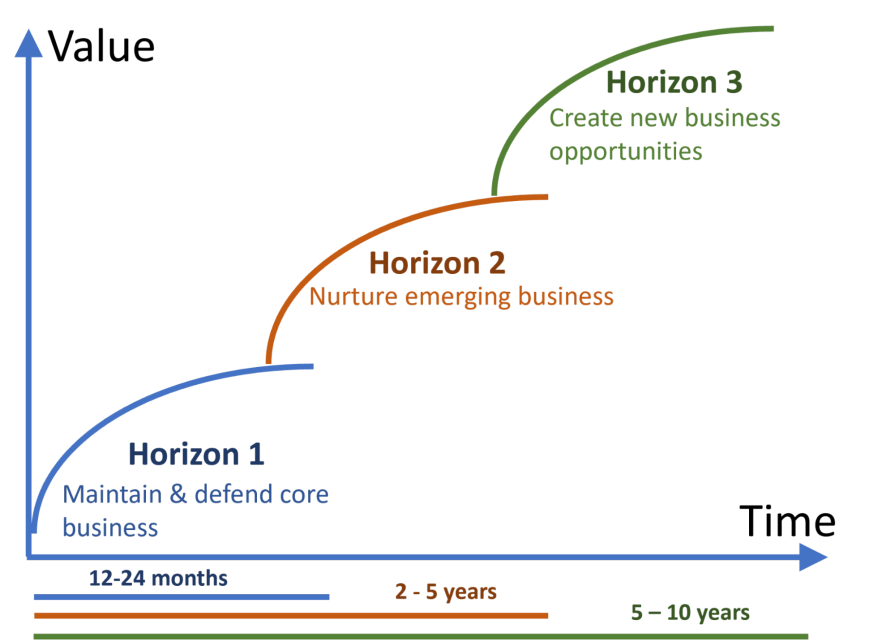Why do big companies like Nokia, Kodak, or Yahoo fail? Although no single reason causes companies to fail, marketing myopia often plays a significant role.

Marketing myopia occurs when a company neglects long-term future opportunities and focuses on short-term goals, thereby missing out on new business opportunities. Established companies need to avoid this by continuously putting effort into growing the business and maintaining a long-term outlook. By doing so, you can mitigate the negative effects of marketing myopia and secure future business.
This article takes a closer look at marketing myopia, examines its causes, and explores possible solutions.
Definition of marketing myopia
In the medical field, myopia refers to the condition of nearsightedness. People with myopia struggle to clearly see distant objects. On the other hand, they can see nearby objects sharply and clearly.
In business, companies struggle with a different kind of myopia — marketing myopia. While marketing myopia certainly won’t mean the end of your business, it can hurt you and lead to a disconnect between you and your users, reducing your revenue and return on investment. Overall, marketing myopia leads to a slower growth rate and a more limited potential for growing your business.
Companies that suffer from marketing myopia focus on:
- Internal topics more than the outside market and user needs
- Short-term goals and immediate future instead of distant future and long-term goals
Examples of marketing myopia
Although marketing myopia varies in intensity, the most pronounced cases tend to be the most interesting. Consider the following examples:
Kodak
Kodak tends to be one of the most referenced examples of marketing myopia. For years, Kodak was the world market leader in the photo and film business. Kodak controlled large parts of the supply chain from the production of analog film, camera technologies, and the development of negatives to the duplication of photos and films.
In 1974, the young Kodak engineer Steve Sassion built the world’s first digital camera. In 1978, Kodak patented the new camera as an intellectual property. The patent became the basis for all digital cameras known today.
However, while every smartphone has a digital camera, the general population no longer uses analog film or prints photos on demand.
Kodak thus lost the core of its business model and finally filed for bankruptcy in 2012. Its focus on short-term earnings from its analog business caused it to ignore the potential for the digital cameras to become the center of the business. The existing business model was simply too lucrative to be distracted by new types of technology.
Nokia
Nokia was once the market leader for mobile phones. In the 2000s (from 2000 to 2006), Nokia dominated the market and was one of the most valuable brands in the world. Nokia focused on the base technologies of civilian mobile communications and small, push-button phones, overlooking the fact that technology and user needs were evolving.
Apple, meanwhile, pursued a different strategy, buying most parts of the base technology from vendors and focusing entirely on user experience and new market demands. By 2016, the dominance of Apple and Samsung made it almost impossible for Nokia to get a slice of the mobile phone/smartphone market.
Smartphones with modern touch screens now dominate the market, causing Nokia phones to disappear from the market. Nokia finally filed bankruptcy and was bought by Microsoft which itself missed out on the opportunity of the smartphone sector.
Microsoft
Microsoft has always focused on providing software and operating systems. When Apple, one of Microsoft’s main competitors, introduced the new iPhone in 2007, Microsoft didn’t realize what a revolutionary change the iPhone would bring to the entire mobile phone industry.
With the advent of the iPhone and Samsung’s Android smartphones, Microsoft missed the opportunity to break into the space. The CPUs in the smartphones had now become so powerful that it was possible to run complex programs and new kinds of operating systems for mobile devices were created.
Apple initially dominated the market with iOS, closely followed by Google with the open-source Android operating system. Microsoft tried to get its own smartphones onto the market and even bought Nokia to bring out its own Windows operating system for mobile devices. Although there are smart devices with Windows today, Microsoft doesn’t play a major role in the smartphone market.
Yahoo
Yahoo was once the key player on the internet. It provided a search engine and a mail service that was easy to use and thereby offered access to the internet to a broad audience. Between 1994 and 2000 Yahoo became one of the most powerful and expensive brands of the new internet economy. Between 2000 and 2004 they had the chance to buy Google but missed the opportunity because they thought 4 Billion US dollars was overpriced for the young search engine company and its technology. But they oversaw that Google and its search engine did something very different. They used metadata and user behavior to improve the search results, thereby offering better search results and better user experience. This led to the downfall of Yahoo, the once-worth 100 billion dollar company lost to its competitor Google and was bought by Verizon at approximately 5 billion dollars in 2016.
Causes of marketing myopia
The examples above show how easily you can fall into the marketing myopia trap. Management requires a balancing act between focusing on the existing business model and developing new segments that allow you to compete in crowded markets.
You can experience marketing myopia because of:
- A poor mix of organization-wide goals — A company that focuses predominantly on short-term goals but neglects medium-term or long-term goals runs the risk of falling victim to marketing myopia
- Resistance to change — Changing a business model requires a lot of effort and can also lead to high financial risk. However, not adapting the business model to changing market conditions isn’t a solution either
- Overconfidence — Market leaders in particular tend to overestimate themselves. These companies often believe in the superiority of their products, and this overconfidence leads to them not taking the actions of the competition seriously enough to adapt their products and marketing strategies accordingly
- Daily business and cash cows — Time-sensitive orders and existing business can be so important that companies simply don’t allocate resources to research and development. To avoid cannibalizing your existing business model, you might actively decide against new products, new marketing strategies, and new business models
- Shareholder pressure — Business shareholders can play a significant role in the development of marketing myopia. Shareholders want to see profits and often favor short-term and medium-term gains over long-term investment and returns
Consequences of marketing myopia
Depending on the phase you find yourself in, and the severity of the marketing myopia, it can mean:
- Certain research and development projects cannot be launched
- Marketing receives resources to market new business models and products
- Entire industries or companies fall into the abyss and have to be shut down
Marketing myopia doesn’t necessarily mean that your company will eventually go bankrupt, but it’s a bias worth monitoring and counteracting if necessary. In a mild case, you lose some market share and fail to grow as much as the competition.
Solutions to avoid marketing myopia
There will always be some form of marketing myopia within a company. However, there are proven strategies that can help reduce the risk of marketing myopia:
Track and measure the success of your marketing strategies
When you roll out bigger marketing strategies, collect data and experiment with A/B testing. By collecting data and analyzing the results, you can decide which strategy works best and what the real market and user needs are.
Keep an eye on new trends
Never underestimate market trends and innovations on the market. Investigate new technologies and market trends and reflect how they can be integrated or used in your product and marketing strategy. You can use Google Trends to research trends and keywords.
Balance day-to-day operations with strategic development
Don’t let your stakeholders and shareholders put pressure on you to favor daily business and income over strategic development. Invest in new business models and products to focus on long-term strategic goals and development.
Plan for the long-, medium-, and short-term
Focus on a range of timeframes with your goal setting. You can use the three-horizon model from McKinsey to keep new business opportunities in focus and set proper long- and mid-term goals:

Allocate resources to new business models and the marketing of new products
Sometimes the daily business requires so much that you end up pouring all your resources into it. To avoid this, allocate resources to new business models and the development of new products, even if they could be used to make more money on the established business models.
Experiment with innovative marketing strategies
Try to come up with forward-thinking marketing strategies to stay ahead of your competition. In combination with the insights and data you gain from marketing campaigns, you can take calculated risks. Here are some examples you can try:
- Integration of AI in your product
- Gamification
- Virtual reality campaigns
- Social media live streams
- Influencer marketing content
Invest in market and user research
Make market research and understanding of your users a top priority. Create buyer personas, collect data, observe market trends, and try to understand the user needs in detail. Conduct customer research by using structured and unstructured interviews or other useful measures. Research the customers and gather these insights before launching new business and implementing new products.
Look at the marketing efforts of your competitors
Focus not only on your marketing strategy and your product, but also keep an eye on your competitors. Ask yourself the following questions:
- How do they market their products?
- What are the core features?
- What marketing campaigns are they rolling out?
- Which audience and customer segments are they targeting?
Key takeaways
All in all, you cannot ignore marketing myopia. As soon as you set up a viable business model, the first effects of marketing myopia can already take effect. However, with suitable countermeasures and user-centered development, product management and marketing teams can take effective actions and significantly reduce the risk.
You need to keep your expenses in balance and invest in both the present and the future. Do this by observing market trends and by allocating sufficient resources to research, development, and marketing.
Featured image source: IconScout